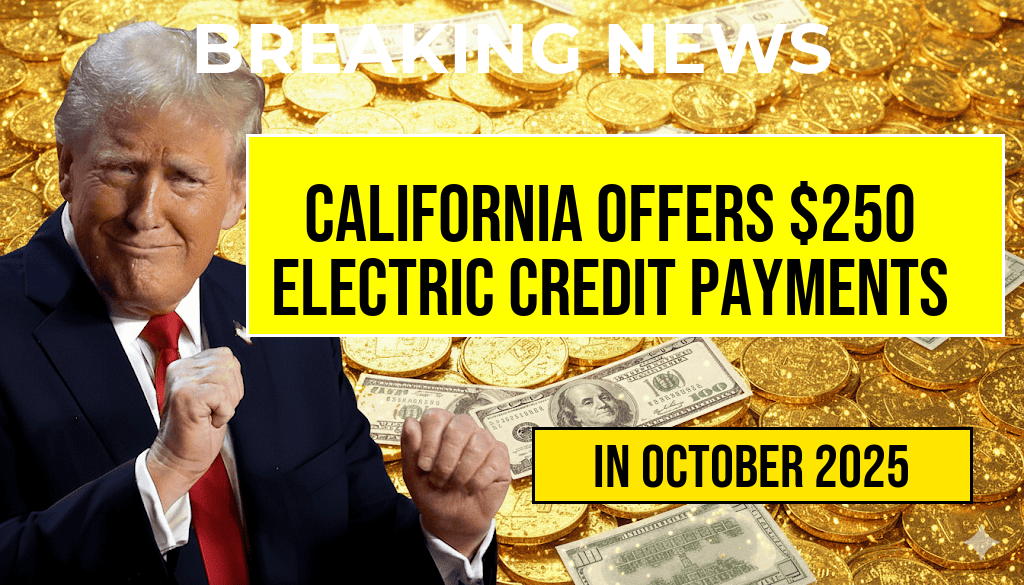California has announced a new initiative providing direct payments of up to $250 to over 11.5 million households, aimed at offsetting energy costs through electric credits. The program, launched by state regulators, requires minimal action from residents—eligible households will automatically receive the funds through their existing utility accounts. This move is part of California’s broader strategy to promote clean energy adoption while alleviating financial burdens amid rising utility bills. The payments are expected to be distributed over the coming months, providing immediate relief to many residents facing increased energy expenses.
Background and Rationale Behind the Electric Credit Program
California’s push toward renewable energy and climate resilience has led to significant investments in clean electricity infrastructure. However, the transition has also resulted in higher utility rates for some consumers, especially those relying heavily on electric appliances and heating. Recognizing this, state officials developed a targeted financial assistance program to ensure affordability and support the transition to greener energy sources.
The program aims to address disparities among households, particularly those with lower income levels, by providing direct financial relief without requiring complex applications or paperwork. According to the California Public Utilities Commission (CPUC), the initiative is designed to be inclusive, ensuring that vulnerable populations are prioritized in the distribution of funds.
Eligibility Criteria and Distribution Process
| Eligibility | Description |
|---|---|
| Household Income | Households earning up to 80% of the Area Median Income (AMI) are eligible, with some variations based on utility provider criteria. |
| Utility Service | Participants must be customers of participating utility companies, including Pacific Gas & Electric, Southern California Edison, and San Diego Gas & Electric. |
| Automatic Enrollment | Most households will be automatically enrolled based on existing utility account data, eliminating the need for applicants to submit separate requests. |
| Payment Amount | Direct payments will be up to $250 per household, with the exact amount determined by household size and energy consumption. |
Implementation Timeline and Financial Impact
The program is slated to roll out over the next several months, with initial disbursements beginning as early as next quarter. State officials estimate that the total cost of the initiative will be approximately $1.2 billion, funded through a combination of energy settlement funds and climate investment allocations.
This initiative aligns with California’s broader climate goals, aiming to reduce greenhouse gas emissions while supporting economic resilience. The direct payments are designed to provide immediate financial relief, helping families manage rising energy costs while fostering continued investment in renewable energy infrastructure.
Community and Industry Reactions
Reactions from community advocates and industry stakeholders have been largely positive. Environmental organizations emphasize that the program not only provides financial relief but also encourages the adoption of cleaner energy sources by reducing economic barriers.
- Environmental groups see it as a necessary step toward equitable energy transition, especially for low-income households disproportionately affected by climate change policies.
- Utility companies have expressed support for the automatic enrollment process, noting it simplifies distribution and reduces administrative burdens.
- Consumer advocacy groups have called for ongoing monitoring to ensure equitable access and to prevent potential issues such as delayed payments or misallocation.
Comparison with Similar Programs in Other States
Several states have implemented similar direct payment initiatives aimed at reducing utility costs amidst rising energy prices. For instance, New York’s Home Energy Assistance Program offers direct subsidies, while Illinois launched a rebate program to offset electricity expenses.
California’s approach distinguishes itself through its broad reach—covering over 11.5 million households—and its seamless, automatic distribution process, which minimizes barriers to access. This model could serve as a blueprint for other states seeking to balance energy transition efforts with economic support measures.
Looking Ahead: Long-term Goals and Potential Challenges
While the immediate focus remains on providing relief, California’s electric credit program also aligns with longer-term ambitions to enhance energy efficiency and accelerate the adoption of renewable technologies. By easing financial pressures, the state hopes to motivate more households to invest in energy-saving appliances and solar installations.
Potential challenges include ensuring timely disbursements, preventing fraud, and maintaining equitable access across diverse communities. Continued oversight and transparent reporting will be essential to maximize the program’s impact and uphold public trust.
As California advances its energy agenda, this direct payment initiative underscores the importance of integrating economic support mechanisms within broader climate policies. It exemplifies how targeted financial assistance can facilitate a just transition to a sustainable energy future.
Frequently Asked Questions
What is the purpose of the direct payments announced by California?
The California government is providing direct payments of up to $250 to over 11.5 million households to help offset electricity costs through electric credits.
Who is eligible to receive the electric credits in California?
Eligible households include residents across California who qualify based on specific income and household criteria. Most households will receive the benefit with minimal action required.
How will Californians receive their payments?
The payments will be issued as direct deposits or prepaid cards, depending on the household’s existing contact information and registration status, with minimal effort needed.
When will the payments be distributed?
The distribution timeline is set to begin shortly after the announcement, with many households expected to receive their electric credits within the upcoming months.
Are there any actions required from households to receive these payments?
Most households will receive the electric credits automatically with minimal action required. However, some may need to verify their eligibility or update contact information through the appropriate state portal.

Leave a Reply